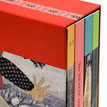| Paul Etienne Lincoln |
The Lure and Draw of Honey's Metaphoric Energy Transfer |
A description of “The Battersea Bee Station,” and “Indicator
for Burg
Vischering.”
The Lure and Draw of Honey’s Metaphoric Energy
Transfer investigates
two unrealized proposals: “The Battersea Bee Station,” 1983
and “Indicator
for Burg Vischering,” 1998-9. Although conceived almost fifteen years
apart,
both centrally manipulate honey’s role as a metaphor for cultural
wealth.
The bee is one of the oldest forms of animal life. In existence since the
Neolithic Age, bees predate human civilization on earth by ten to twenty
million years. This delicate, complex creature has procured for humanity
honey, propolis, royal jelly, beeswax and, most important of all, the fertilization
of many of our crop-bearing plants. According to Greek mythology,
the infant Zeus, out of gratitude for the honey that sustained him, gave
the
honeybee its sting for defense. Because the bee abused this power, Zeus
later decreed that whenever the sting was administered the unfortunate
bee must die. Ironically, humans have developed the means to milk
Isopentyl acetate from bees and to use this substance as a treatment for
bee
venom hypersensitivity and for the relief of arthritic individuals.
Honey has been readily associated with cultural wealth by writers and
philosophers throughout history, the hive being a recurring analogy for
human civilization. Bernard Mandeville (1670-1733), a Dutch Doctor of
Medicine specializing in Hypochondriack and Hysterick
Passions, moved to
England and penned the poem “The Grumbling Hive” and a series
of essays
arguing the necessity of vice as the foundation of the emerging capitalist
economy. Ridiculed and condemned as a “Public Nuisance,” Mandeville’s
The Fable of the Bees, as the collection became known, describes a flourishing
beehive resembling England, even to the unique advantage of being
happily governed by a limited monarchy. The most noticeable characteristic
of this beehive or nation is its addiction to vice, especially to fraud,
luxury
and pride. As described by Mandeville, the committing of crime, for example,
is responsible for keeping whole multitudes at work: lawyers, gaolers,
turnkeys, sergeants, bailiffs, tipstaffs and locksmiths.
Then on a cloud
the Hood-winke’d fair
Justice her self was push’d by Air:
About her chariot, and behind,
Were sergeants, Bums of every kind,
Tip-staffs, and all those Officers,
That squeeze a living out of Tears.¹
As for the vices of luxury, avarice,
prodigality, pride, envy and vanity
displayed by the more respectable members of society, these promote trade
by creating wants, which can only be satisfied by merchants, tradesmen
and manufacturers of supply. Under ordinary circumstances we might
expect that the wicked bees, in spite of temporary prosperity, would ultimately
come to grief as a result of their numerous sins. But while misfortune
does become their lot, this reversal comes about only when the knaves
are suddenly turned honest. With the ensuing absence of the crimes that
created employment and the vices that fostered trade, the professions decay,
commerce dwindles, thousands of unemployed emigrate and the hives’
prosperity comes to an end.²
1. Bernard Mandeville,
“The Grumbling Hive or
Knaves Turn’d Honest,”
The Fable of the Bees,
Public Vices, Public
Benefits (London, near the
Oxford Arms in Warwick
Lane: J. Roberts, 1714).
2. See Phillip Harth,
Preface Notes to The Fable
of the Bees (London:
Penguin Books, 1970).
—
PAUL ETIENNE LINCOLN creates elaborate installations and allegorical
machines that investigate circumstances. Projects include a study of
Madame de
Pompadour’s effect on the Court of Louis XV, and the technological
infrastructure
of New York City. Recent books are A Violet Somnambulist
Spiriting the Fugacious
Bloom, The Metropolis of Metaphorical Intimations and, most recently,
Sinfonia
Torinese, and The Velocity of Thought.
For the complete article purchase The Sienese Shredder #1
Back to The Sienese Shredder #1
| 

